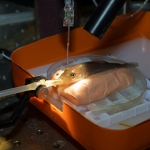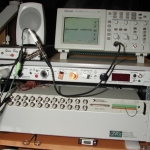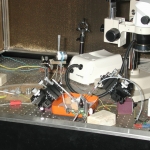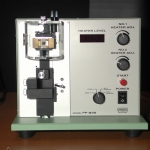Electrophysiological recordings allow investigators to determine the physiological responses of animals to their surroundings and the manner in which sensory information is gathered and coded by the central nervous system. Essentially, the technique allows us to ask organisms what they see, smell, hear and feel (i.e., the tactile sense). Thus, this approach is used to evaluate sensory responses to various stimuli (such as those that would be present under different rearing conditions) and also how these responses change with age, developmental state, stress, nutritional condition, endocrine status, reproductive maturity, etc. Although applied mainly to larger animals, it is now possible to make such measurements on larvae. This technique enables us to address, by direct measurement, such fundamentally important issues as the olfactory and mechanosensory responses to sets of stimuli that are present in alternative rearing systems. As with the MSP technique for the visual environment, such information allows us to evaluate how we might improve rearing conditions by considering the compounding effects of olfactory, mechanosensory and visual stimuli. In addition to generating information of direct relevance to aquaculture, these techniques allow us to address more fundamental questions related to the development of information processing in fishes and how this might be affected by the environment at different points in the life history (for example, during ?critical periods?). Such an analysis at the electrophysiological level can then be compared to results from analogous studies at the morphological and behavioural levels.
Please click on the images to obtain further details about this equipment.





